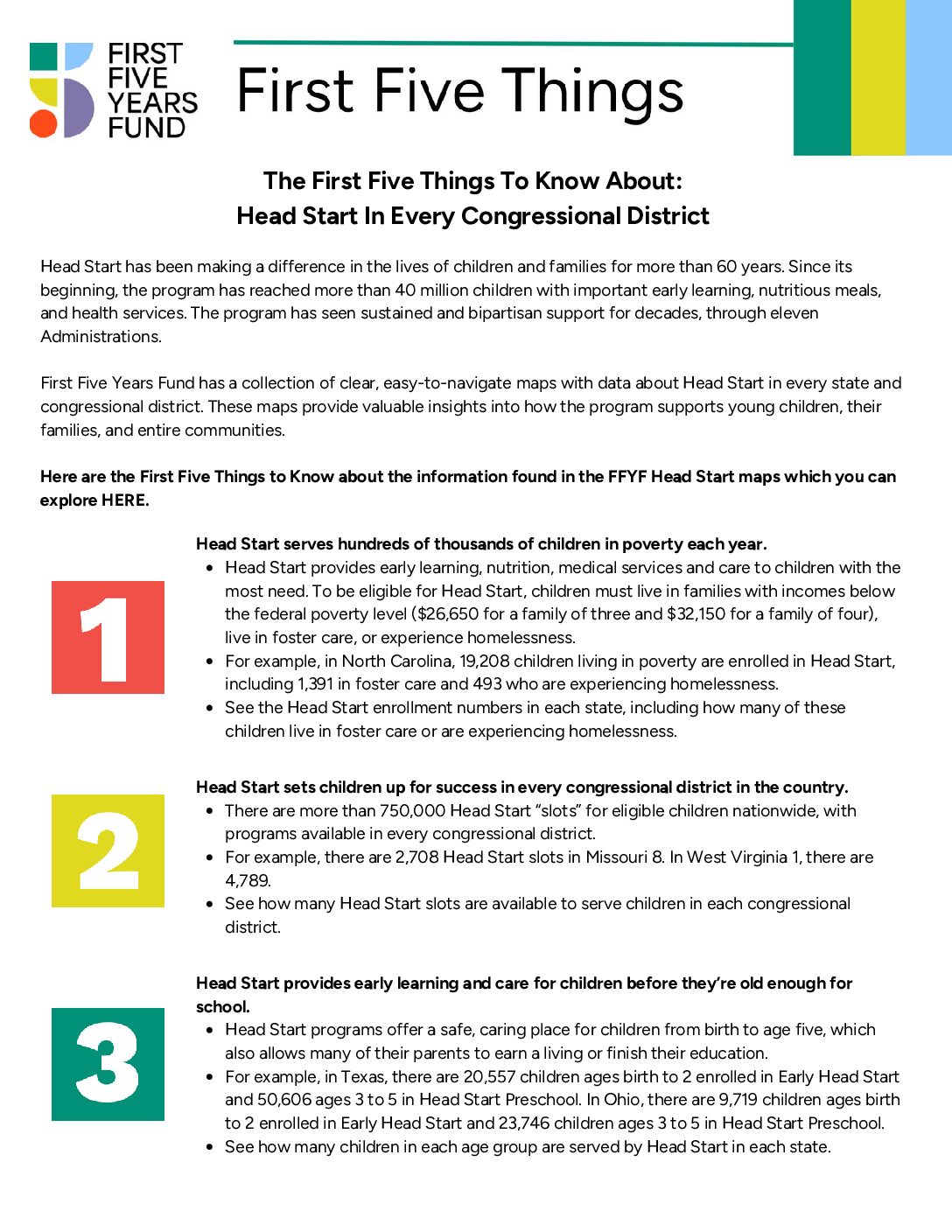The First Five Things to Know About: Head Start In Every Congressional District

Head Start has been making a difference in the lives of children and families for more than 60 years. Since its beginning, the program has reached more than 40 million children with important early learning, nutritious meals, and health services. The program has seen sustained and bipartisan support for decades, through eleven Administrations.
First Five Years Fund has a collection of clear, easy-to-navigate maps with data about Head Start in every state and congressional district. These maps provide valuable insights into how the program supports young children, their families, and entire communities.
Here are the First Five Things to Know about the information found in the FFYF Head Start maps which you can explore HERE.

Head Start serves hundreds of thousands of children in poverty each year.
- Head Start provides early learning, nutrition, medical services and care to children with the most need. To be eligible for Head Start, children must live in families with incomes below the federal poverty level ($26,650 for a family of three and $32,150 for a family of four), live in foster care, or experience homelessness.
- For example, in North Carolina, 19,208 children living in poverty are enrolled in Head Start, including 1,391 in foster care and 493 who are experiencing homelessness.
- See the Head Start enrollment numbers in each state, including how many of these children live in foster care or are experiencing homelessness.

Head Start sets children up for success in every congressional district in the country.
- There are more than 750,000 Head Start “slots” for eligible children nationwide, with programs available in every congressional district.
- For example, there are 2,708 Head Start slots in Missouri 8. In West Virginia 1, there are 4,789.
- See how many Head Start slots are available to serve children in each congressional district.

Head Start provides early learning and care for children before they’re old enough for school.
- Head Start programs offer a safe, caring place for children from birth to age five, which also allows many of their parents to earn a living or finish their education.
- For example, in Texas, there are 20,557 children ages birth to 2 enrolled in Early Head Start and 50,606 ages 3 to 5 in Head Start Preschool. In Ohio, there are 9,719 children ages birth to 2 enrolled in Early Head Start and 23,746 children ages 3 to 5 in Head Start Preschool.
- See how many children in each age group are served by Head Start in each state.

Federal funding supports local Head Start programs in every congressional district.
- Head Start operates under a federal-to-local model. Federal funding is awarded to local organizations which then work with teachers, parents and community members to design Head Start programs that meet the unique needs of the children and families they serve.
- Additionally, many organizations maximize Head Start funds by blending them with funding from states and other sources to create high-quality programs that serve even more children and families, forming statewide systems of early learning and care.
- Find the level of federal funding for Head Start programming which supports early learning and care services in each congressional district.

Head Start has strong support among voters nationwide.
- Along with the data found in the maps, it is important to note that Head Start has strong public support across all demographics.
- In 2025 polling, four out of five (79%) voters say they support Head Start, including 73% of Republicans, 76% of Independents, and 86% of Democrats.
- Head Start also has wide support across geographic, age, and ethnicity demographics, including 80% of urban voters, 80% of suburban voters, and 76% of rural voters.
Learn more:
- Explore our Head Start Maps
- Read the Head Start program overview
- Find your Head Start State Fact Sheet
Subscribe to FFYF First Look
Every morning, FFYF reports on the latest child care & early learning news from across the country. Subscribe and take 5 minutes to know what's happening in early childhood education.




